【C++】vector 的使用和底层
目录
总述
构造函数
迭代器
reserve、resize
元素访问
增删查改
查找(算法库)
模拟实现
注意事项
1.
2. 扩容引发迭代器失效
3. 深拷贝的自定义类型对象
4.
STL 的设计有通用性,string 和 vector 的使用有很多相似之处,二者用法重复的地方不在过多说明
总述

顺序表,由数组实现
Alloc 是空间配置器,内存池。以后会讲空间配置器跟这里是如何配合的
vector<char> strV;
string str;vector 不能替代 string:
1. string要求最后有\0,更好兼容c接口
2. string有很多他的专用接口函数

构造函数
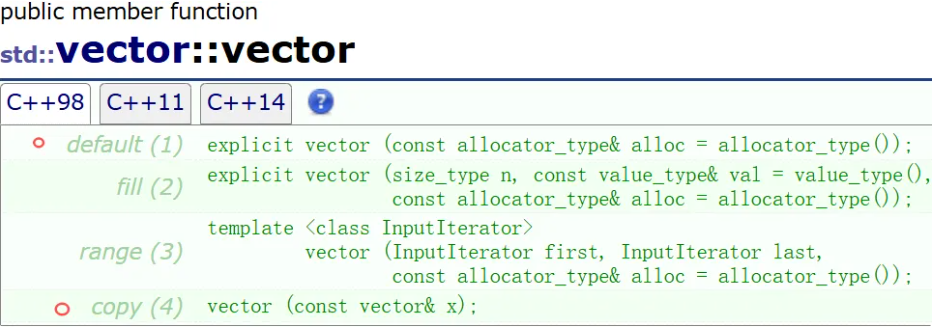
1. 无参构造 可以自己写内存池,但我们用它的就好
2. 构造并初始化 n 个 val
3. 用迭代器进行初始化构造
4. 拷贝构造
实例化可以给任意类型;迭代器区间可以是其他类型的迭代器
#include <string>
#include <vector>
#include <iostream>
using namespace std;int main()
{vector<int> v1(5, 1);vector<string> v2(5, "***");for (auto e : v1){cout << e << " "; // 1 1 1 1 1}cout << endl;for (auto e : v2){cout << e << " "; // *** *** *** *** ***}cout << endl;vector<int> v3(v1.begin(), v1.end());for (auto e : v3){cout << e << " "; // 1 1 1 1 1}cout << endl;string str("hello world");vector<char> v4(str.begin(), str.end());for (auto e : v4){cout << e; // hello world}cout << endl;// 迭代器底层可能是指针int a[] = { 16,2,77,29 };vector<int> v5(a, a + sizeof(a) / sizeof(a[0]));for (auto e : v5){cout << e << " "; // 16 2 77 29}cout << endl;return 0;
}单参数的构造函数支持隐式类型转换:
string 支持单参数的构造函数,参数是 const char
==> const char* 的字符串可以隐式类型转换成 string
所以可以 v.push_back("张三");
vector<vector<int>> vv;
vector<string> v;string name1("张三");
v.push_back(name1);
v.push_back(string("张三")); // 匿名对象
v.push_back("张三");class A
{int _a;
public:A(int a):_a(a){}
};A a1(1);
A a1 = 1;迭代器
构造函数中有一些迭代器举例
都是 [ ) 的区间
vector 的3种遍历方法:↓
#include <string>
#include <vector>
#include <iostream>
using namespace std;int main()
{vector<int> v;v.push_back(1);v.push_back(2);v.push_back(3);v.push_back(4);for (size_t i = 0; i < v.size(); i++){cout << v[i] << " ";}cout << endl;vector<int>::iterator it = v.begin();while (it != v.end()){cout << *it << " ";it++;}cout << endl;for (auto e : v){cout << e << " ";}cout << endl;return 0;
}排序:↓

#include <vector>
#include <iostream>
#include <algorithm> // 算法头文件
using namespace std;int main()
{int a[] = { 16,2,77,29,3 };vector<int> v1(a, a + sizeof(a) / sizeof(a[0]));sort(v1.begin(), v1.end()); // 升序//sort(v1.rbegin(), v1.rend()); // 降序for (auto e : v1){cout << e << " ";}cout << endl;// 迭代器底层可能是指针sort(a, a + sizeof(a) / sizeof(a[0]));for (auto e : a){cout << e << " ";}cout << endl;return 0;
}降序的函数写法:↓
int a[] = { 16,2,77,29,3 };vector<int> v1(a, a + sizeof(a) / sizeof(a[0]));// 降序//greater<int> gt;//sort(v1.begin(), v1.end(), gt);sort(v1.begin(), v1.end(), greater<int>()); // 匿名对象for (auto e : v1){cout << e << " ";}cout << endl; // 给空格也排序了string str("hello world");sort(str.begin(), str.end()); // dehllloorwcout << str << endl; reserve、resize
和 string 一样,reserve 只改变 _capacity;resize 也改变有效数据个数 _size
vector<int> v1;//v1.reserve(10);v1.resize(10);for (size_t i = 0; i < 10; i++){v1[i] = i;// 如果用 v1.reserve(10); 应该这样写// v1.push_back(i);}for (auto e : v1){cout << e << " ";}cout << endl;使用 reserve 会发生越界访问,程序直接挂掉。
因为 reserve 只改变了 _capacity,此时 s 的 有效数据个数_size == 0
重载的 [ ] 是按有效数据来的,会断言检查
元素访问
对越界的检查:
operator [ ]:assert断言
at:抛异常

data 类似于 c_str
value 是 T,返回 T* ==> 返回 T类对象 数组的指针
增删查改

当前值清了,重新赋值
int a[] = { 29,3,33,43,3,2,3,3,2 };
vector<int> v1(a, a + sizeof(a) / sizeof(int));v1.assign(5, 1);
for (auto e : v1)
{cout << e << " "; // 1 1 1 1 1
}
cout << endl;尾插:push_back
尾删:pop_back
没有直接提供头插、头删,可以用 insert、erase
string 是以下标插入。往后都是迭代器

在某个位置插入1个、n个值;迭代区间
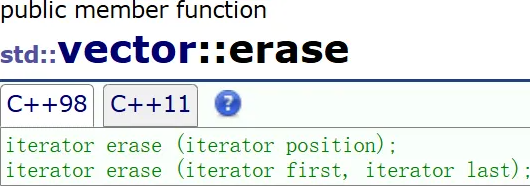
int a[] = { 16,2,77,29,3,33 };vector<int> v1(a, a + sizeof(a) / sizeof(int));// 头删v1.erase(v1.begin());// 头插 v1.insert(v1.begin(), 100);// 删除第3个数据v1.erase(v1.begin() + 2);for (auto e : v1){cout << e << " "; // 100 2 29 3 33}cout << endl; vector<int> v1(3, 100); // 100 100 100vector<int>::iterator it = v1.begin();std::vector<int> v2(2, 400);v1.insert(it + 2, v2.begin(), v2.end()); // 100 100 400 400 100int a[] = { 501,502,503 };v1.insert(v1.begin(), a, a + 3);for (auto e : v1){cout << e << " "; // 501 502 503 100 100 400 400 100}cout << endl;查找(算法库)
想删除3,但是不知道3在哪,用算法库里的find

迭代器失效
int a[] = { 29,3,33,43,3,2,3,3,2 };vector<int> v1(a, a + sizeof(a) / sizeof(int));//vector<int>::iterator pos = find(v1.begin(), v1.end(), 3);auto pos = find(v1.begin(), v1.end(), 3);//if (pos != v1.end())//{// v1.erase(pos);//}// 删除所有的3 -- 涉及迭代器失效!后面解决while (pos != v1.end()){v1.erase(pos);// pos = find(pos + 1, v1.end(), 3); // 迭代器失效pos = find(v1.begin(), v1.end(), 3); // 成功,但是效率低}for (auto e : v1){cout << e << " ";}cout << endl;模拟实现
模版不能声明、定义分离,模版进阶时讲
vector.h
#pragma once
#include <assert.h>
#include <iostream>
#include <string>
using namespace std;namespace qtw
{template<class T>class vector{public:typedef T* iterator;typedef const T* const_iterator;iterator begin(){return _start;}iterator end(){return _finish;}const_iterator begin() const{return _start;}const_iterator end() const{return _finish;}vector()//:_start(nullptr)//,_finish(nullptr)//,_endofstorage(nullptr)// 成员变量给了缺省值,这里就不用在初始化列表初始化了{ }vector(size_t n, const T& val = T()){resize(n, val);}vector(int n, const T& val = T()) // 为什么加这个构造函数? 注意事项 4.{resize(n, val);}// [first, last)//vector(iterator first, iterator last) 不这样写// 这样写只能使用vector的迭代器初始化(不通用)// 类模板里面还可以再套模板template<class InputIterator>vector(InputIterator first, InputIterator last){while (first != last){push_back(*first);++first;}}vector(const vector<T>& v) // 传统{_start = new T[v.capacity()];//memcpy(_start, v._start, sizeof(T) * v.size()); 深拷贝的自定义类型对象会出问题for (size_t i = 0; i < v.size(); i++){_start[i] = v._start[i];}_finish = _start + v.size();_endofstorage = _start + v.capacity();}//vector(const vector<T>& v) // 复用//{// reserve(v.capacity());// for (auto e : v)// {// push_back(e);// }//}void swap(vector<T>& v){std::swap(_start, v._start);std::swap(_finish, v._finish);std::swap(_endofstorage, v._endofstorage);}vector<T>& operator=(vector<T> v) // 现代写法{swap(v);return *this;}~vector(){if (_finish){delete[] _start;_start = _finish = _endofstorage = nullptr;}}void reserve(size_t n){if (n > capacity()){size_t sz = size(); // 保存size,下面会被迫改变T* tmp = new T[n];if (_start){//memcpy(tmp, _start, sizeof(T) * size()); 深拷贝的自定义类型对象会出问题for (size_t i = 0; i < sz; i++){tmp[i] = _start[i];}delete[] _start;}_start = tmp; // 间接改变了size_finish = _start + sz;_endofstorage = _start + n;}}// T类型的匿名对象,调用T的默认构造。所以自己写类,默认构造要自己提供// C++模板出来后,对内置类型升级:内置类型也有构造函数void resize(size_t n, const T& val = T()){if (n < size()){_finish = _start + n;}else{reserve(n);while (_finish != _start + n){*_finish = val;_finish++;}}}void push_back(const T& x){if (_finish == _endofstorage){size_t newcapacity = capacity() == 0 ? 4 : capacity() * 2;reserve(newcapacity);}*_finish = x;_finish++;//insert(end(), x);}size_t size() const{return _finish - _start;}size_t capacity() const{return _endofstorage - _start;}iterator& operator[](size_t pos){assert(pos < size());return *(_start + pos);}const_iterator& operator[](size_t pos) const{assert(pos < size());return *(_start + pos);}iterator insert(iterator pos, const T& x){assert(pos >= _start && pos <= _finish);if (_finish == _endofstorage){size_t len = pos - _start;size_t newcapacity = capacity() == 0 ? 4 : capacity() * 2;reserve(newcapacity);pos = _start + len; // 相对位置,重置迭代器位置}iterator end = _finish - 1;while (end >= pos){*(end + 1) = *end;--end;}*pos = x;_finish++;return pos;}iterator erase(iterator pos){assert(pos >= _start && pos < _finish);iterator it = pos + 1;while (it != _finish){*(it - 1) = *it;++it;}_finish--;return pos;}private:iterator _start = nullptr;iterator _finish = nullptr;iterator _endofstorage = nullptr;};
}注意事项
1.
void reserve(size_t n){if (n > capacity()){size_t sz = size(); // 保存size,下面会被迫改变T* tmp = new T[n];if (_start){memcpy(tmp, _start, sizeof(T) * size());delete[] _start;}_start = tmp; // 改变了size_finish = _start + sz;_endofstorage = _start + n;}}size_t size() const{return _finish - _start;}用 _start 计算 size;_start = tmp 这一步间接改变了 size
如果不保存 size, _finish = _start + size(); _finish 拿到的是0x00000000这个进程地址空间
所以,要么加上 size_t sz = size(); 这句,要么先算 _finish 再算 _start
2. 扩容引发迭代器失效
iterator insert(iterator pos, const T& x){assert(pos >= _start && pos <= _finish);if (_finish == _endofstorage){size_t len = pos - _start;size_t newcapacity = capacity() == 0 ? 4 : capacity() * 2;reserve(newcapacity);pos = _start + len; // 相对位置,重置迭代器位置}iterator end = _finish - 1;while (end >= pos){*(end + 1) = *end;--end;}*pos = x;_finish++;return pos;}void qtw_test1()
{qtw::vector<int> v;v.push_back(1); v.push_back(2);v.push_back(3); v.push_back(4);v.push_back(5); v.push_back(5);v.push_back(5);for (auto e : v) { cout << e << " "; }cout << endl; // 1 2 3 4 5 5 5v.insert(v.begin(), 100);for (auto e : v) { cout << e << " "; }cout << endl; // 100 1 2 3 4 5 5 5qtw::vector<int>::iterator p = v.begin() + 3;v.insert(p, 300);for (auto e : v) { cout << e << " "; }cout << endl; // 100 1 2 300 3 4 5 5 5// 高危行为*p += 10;for (auto e : v) { cout << e << " "; }cout << endl; // 100 1 2 300 3 4 5 5 5
}insert扩容以后迭代器可能会失效;所以insert扩容以后就不要使用这个形参迭代器了
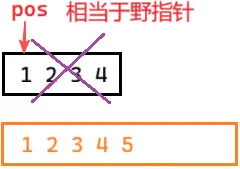
erase以后,迭代器失效了,不能访问
vs进行强制检查,访问会直接报错
void qtw_test2()
{std::vector<int> v1;v1.push_back(1); v1.push_back(2); v1.push_back(2); v1.push_back(3);v1.push_back(4); v1.push_back(5);v1.push_back(6);for (auto e : v) { cout << e << " "; }cout << endl;auto it = v1.begin();v1.erase(it);cout << *it << endl;++it;cout << *it << endl;for (auto e : v) { cout << e << " "; }cout << endl;
}程序直接挂掉
怎么解决?接收返回值
void qtw_test2()
{std::vector<int> v1;v1.push_back(1); v1.push_back(2); v1.push_back(2); v1.push_back(3);v1.push_back(4); v1.push_back(5);v1.push_back(6);for (auto e : v) { cout << e << " "; }cout << endl;auto it = v1.begin();while (it != v1.end()){if (*it % 2 == 0){it = v1.erase(it); // 不接收属于迭代器失效}else{++it;}}for (auto e : v) { cout << e << " "; }cout << endl;
}总结:vector 的 erase和insert 迭代器对象后,不能再访问这个迭代器。迭代器失效了,访问结果是未定义
3. 深拷贝的自定义类型对象
vector(const vector<T>& v) // 传统
{_start = new T[v.capacity()];memcpy(_start, v._start, sizeof(T) * v.size()); //深拷贝的自定义类型对象会出问题//for (size_t i = 0; i < v.size(); i++)//{// _start[i] = v._start[i];//}_finish = _start + v.size();_endofstorage = _start + v.capacity();
}void reserve(size_t n)
{if (n > capacity()){size_t sz = size(); // 保存size,下面会被迫改变T* tmp = new T[n];if (_start){memcpy(tmp, _start, sizeof(T) * size()); //深拷贝的自定义类型对象会出问题//for (size_t i = 0; i < sz; i++)//{// tmp[i] = _start[i];//}delete[] _start;}_start = tmp; // 间接改变了size_finish = _start + sz;_endofstorage = _start + n;}
}void qtw_test5()
{qtw::vector<string> v;v.push_back("111111111111111111");v.push_back("222222222222222222");v.push_back("333333333333333333");v.push_back("444444444444444444");v.push_back("555555555555555555");for (auto& e : v) // 拷贝代价大,所以引用{cout << e << " ";}cout << endl;qtw::vector<string> v1(v);for (auto& e : v1){cout << e << " ";}cout << endl;
}push_back "5",扩容时程序挂掉
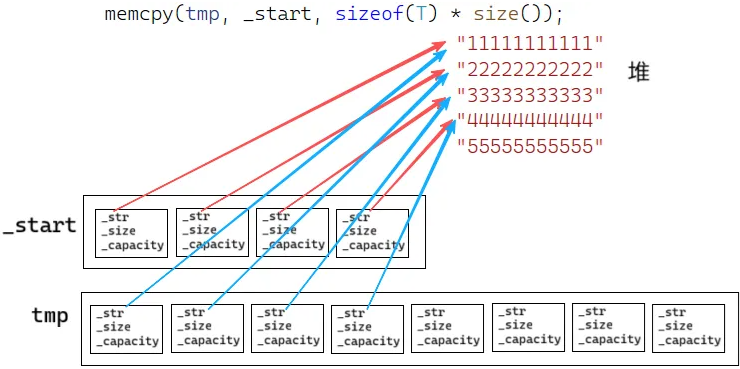
vector是深拷贝,但vector空间上存的是string对象
string对象应该是拷贝,但memcpy是浅拷贝
delete[] _start;当T是自定义类型时,一次调用vector里每个对象的析构函数,再释放整个空间
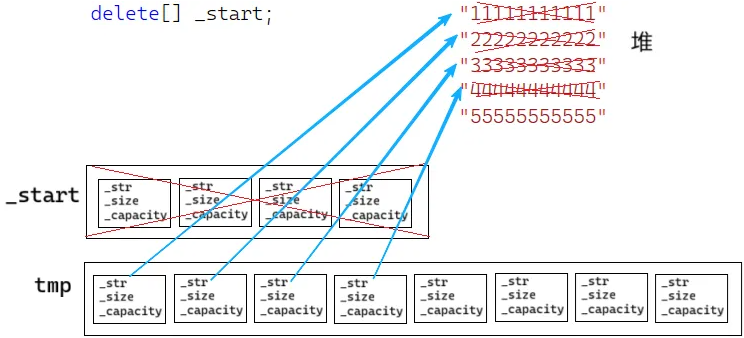
解决方案:
T是深拷贝的类,要调用赋值重载,实现类对象的深拷贝
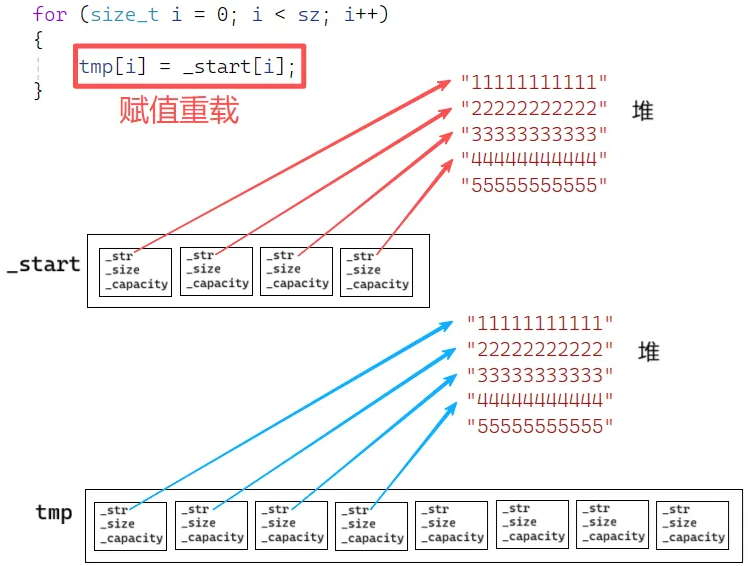
4.
vector(size_t n, const T& val = T())
{resize(n, val);
}// [first, last)
//vector(iterator first, iterator last) 不这样写:只能使用vector的迭代器初始化(不通用)
// 类模板里面还可以再套模板
template<class InputIterator>
vector(InputIterator first, InputIterator last)
{while (first != last){push_back(*first);++first;}
}void qtw_test6()
{qtw::vector<int> v(10, 1); // 报错qtw::vector<int> v1(10u, 1);qtw::vector<string> v2(10, "1111");
}v1,v2没问题,v报错
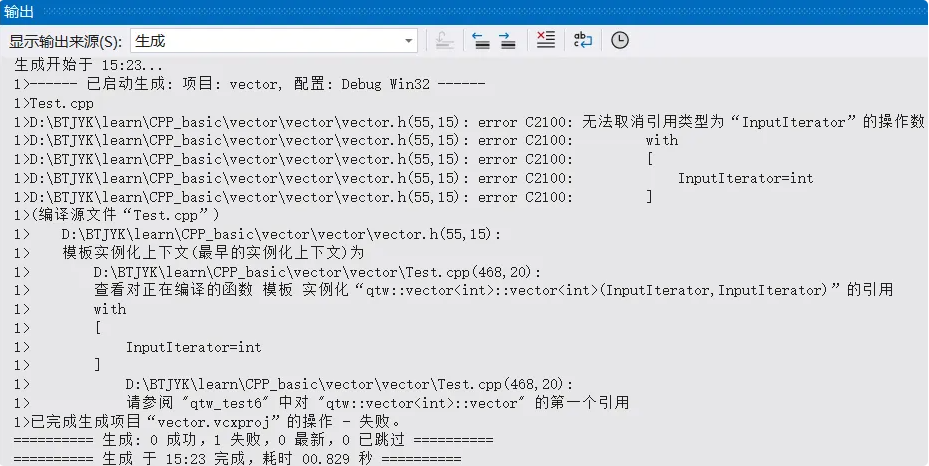
v 调用成了迭代器,迭代器更匹配。因为上面的构造函数一个是 size_t,一个是 int。v 的(10, 1)都是 int,调成了迭代器,first、last都被识别成 int,但 int 不能解引用,报错
v1让编译器把 10识别为size_t,1还是int,便因类型不同无法调用模板。和 v2 一样别无他选
库里面怎么解决的呢?
![]()
vector(size_t n, const T& val = T())
{resize(n, val);
}vector(int n, const T& val = T())
{resize(n, val);
}// [first, last)
//vector(iterator first, iterator last) 不这样写:只能使用vector的迭代器初始化(不通用)
// 类模板里面还可以再套模板
template<class InputIterator>
vector(InputIterator first, InputIterator last)
{while (first != last){push_back(*first);++first;}
}本篇的分享就到这里了,感谢观看,如果对你有帮助,别忘了点赞+收藏+关注。
小编会以自己学习过程中遇到的问题为素材,持续为您推送文章
